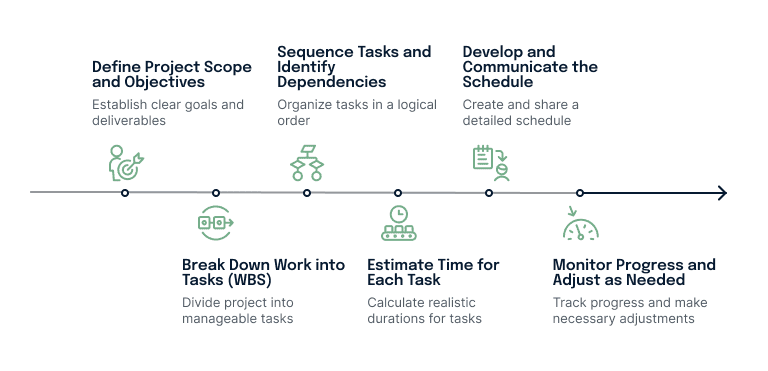project management · Sep 23, 2025
Mastering Time Management in Project Management: Strategies, Steps, and Tools

Time is the invisible thread that connects every stage of a project. From initiation and planning to execution and closure, time management determines whether tasks progress smoothly or spiral into delays. Whether you’re running a three-month marketing campaign or managing a multi-year construction project, effective time management can make or break success.
Poor time management often leads to missed deadlines, wasted resources, and frustrated stakeholders. On the other hand, strong project time management keeps teams aligned, reduces risks, and ensures deliverables are completed within scope and budget. In fact, a PMI survey revealed that nearly 48% of projects fail to meet deadlines due to poor scheduling practices—highlighting just how critical this skill is.
This blog post dives into what time management in project management really means, why it matters, step-by-step processes for managing it, strategies you can apply, and tools to make it easier.
What is Time Management in Project Management?
Time management in project management is the structured process of planning, scheduling, monitoring, and controlling project activities to ensure deadlines are met.
It’s a core element of the project management triangle—time, cost, and scope. If timelines slip, costs typically increase, and scope often suffers.
The objectives of project time management include:
- Developing realistic schedules that balance ambition and feasibility.
- Sequencing and breaking down tasks into smaller, trackable parts.
- Monitoring timelines to identify risks of delay early.
- Maximizing efficiency under resource and scope constraints.
For example, in software development, sprint planning ensures features are delivered in two-week cycles. Each sprint has deadlines, task dependencies, and testing phases. Without structured time management, one missed QA deadline can cascade into delays across the entire release cycle.
Importance of Time Management in Project Management
1. Improves Project Efficiency
Strong time management ensures tasks are prioritized and resources are allocated effectively, eliminating wasted effort. For instance, construction firms often use Critical Path Method (CPM) scheduling to identify which tasks must be completed on time to prevent bottlenecks. This keeps projects efficient and avoids costly downtime.
2. Reduces Risks and Uncertainty
Time management directly supports risk management. Building realistic timelines and buffers allows managers to anticipate problems before they occur. In IT projects, it’s common to allocate buffer days for unexpected bugs. Without such foresight, a single unresolved issue can derail an entire launch schedule.
3. Enhances Stakeholder Communication
A transparent timeline improves communication between project managers, teams, and stakeholders. Everyone knows deadlines, dependencies, and deliverables, which minimizes misunderstandings. Marketing campaigns are a prime example—when designers, copywriters, and media buyers share a visible timeline, coordination becomes seamless.
4. Controls Project Scope and Cost
Delays frequently lead to higher costs—whether through overtime, additional contractors, or penalties. Strong time management ensures projects stay within scope and budget. Consider the Denver International Airport baggage system failure, which went $560 million over budget largely due to poor scheduling and unrealistic timelines.
5. Boosts Team Morale and Productivity
Clear timelines give teams structure and reduce last-minute stress. A Harvard Business Review study found employees working under predictable schedules reported 55% higher satisfaction compared to those with chaotic ones. By reducing uncertainty, teams remain motivated and engaged.
6 Steps to Manage Time in Project Management

Step 1: Define Project Scope and Objectives
You can’t manage time without clear objectives. Scope defines what needs to be delivered, which directly influences the schedule. For example, launching an app requires knowing if it’s for iOS, Android, or both. Without clarity, time estimates are guesswork.
Step 2: Break Down Work into Tasks (WBS)
A Work Breakdown Structure (WBS) divides the project into manageable tasks. This helps estimate timelines and assign responsibilities accurately. Instead of “launch a website,” tasks become “design wireframes,” “develop UI,” and “set up hosting.”
Step 3: Sequence Tasks and Identify Dependencies
Projects often have interdependent tasks. Visualizing them through Gantt charts or Kanban boards helps ensure sequencing is realistic. For instance, in event planning, you can’t finalize catering until the venue is secured.
Step 4: Estimate Time for Each Task
Accurate time estimates are crucial. Teams can use historical data, expert input, or methods like PERT (Program Evaluation and Review Technique) to calculate realistic durations. Agile teams often rely on sprint velocity from past iterations.
Step 5: Develop and Communicate the Schedule
With estimates in place, create a detailed schedule with milestones and buffer times. Share this across the team to align expectations. Tools like Quire’s Timeline View or integrated calendars ensure everyone has visibility.
Step 6: Monitor Progress and Adjust as Needed
Projects rarely go 100% to plan. Regular check-ins, dashboards, and retrospectives allow managers to adjust timelines when issues arise. Agile teams, for example, hold sprint reviews to recalibrate upcoming tasks.
Strategies for Time Management in Project Management
Beyond the steps, practical strategies make time management more effective. Here are some proven techniques:
- Prioritize with the Eisenhower Matrix: Distinguish urgent vs. important tasks to focus on value-adding work.
- Apply Timeboxing: Allocate fixed time slots to tasks to prevent overthinking or scope creep.
- Set Milestones for Motivation: Breaking projects into milestones gives teams a sense of progress.
- Use the Pareto Principle (80/20 Rule): Identify the 20% of tasks that deliver 80% of project results.
- Automate Routine Work: Use project management tools to send reminders, update dashboards, or manage recurring tasks.
These strategies align closely with the earlier six steps, making them easier to execute consistently.
Project Time Management Tools for Your Team
Different tools support different aspects of project time management. Here are the main categories:
- Scheduling Tools: For visualizing deadlines and dependencies (e.g., Microsoft Project, Quire Timeline, Smartsheet).
- Task Management Tools: For day-to-day tracking with Kanban boards or lists (e.g., Quire, Trello, Asana).
- Collaboration Tools: For real-time communication and file sharing (e.g., Slack, Microsoft Teams).
- Time Tracking Tools: For monitoring how long tasks actually take (e.g., Harvest, Toggl).
When choosing tools, consider usability, scalability, and integration. The best tools are the ones your team will actually adopt and consistently use.
How Quire Helps with Project Time Management
Quire brings planning, scheduling, and execution into one seamless platform. Here’s how it makes time management easier:
- Timeline View: Visualize deadlines, dependencies, and milestones in one glance.
- Kanban Boards: Organize tasks into clear stages for smoother execution.
- Sublists: Focus on specific deliverables or milestones without losing sight of the big picture.
- Reminders & Notifications: Automate alerts so deadlines are never overlooked.
- Calendar Integration: Sync with Google Calendar for seamless personal and team scheduling.
With Quire, teams can plan, execute, and adjust their timelines in one platform—reducing risks, saving time, and boosting collaboration.
Take control of your project schedules today. Try Quire and empower your team with smarter time management.

